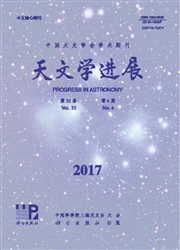

 中文摘要:
中文摘要:
贫金属星一般指形成于宇宙早期的年老恒星,近几年观测发现的几颗极贫金属星,推测其年龄与银河系年龄相近。通过研究它们的锂丰度可以为银河系及早期恒星的形成与演化研究提供观测限制。对金属丰度较低,且Teff〉5700K的主序星进行研究发现,其锂丰度与金属丰度和有效温度无关,这种现象被称为“锂丰度平台”。随着样本数的增加,一些研究发现锂丰度与金属丰度和有效温度之间有一定的相关性。对贫金属星的样本分析结果显示,锂丰度平台在贫金属端的恒定性被破坏,具体表现为锂丰度随金属丰度的降低而急剧下降,并且伴随更大的弥散。对此有两种的解释:(1)不同的研究手段或分析方法给出不同的锂丰度值,使得样本呈现出锂平台被破坏的现象;(2)有相应的物理机制使得样本中的锂被消耗。诞生于宇宙早期的贫金属星,其锂丰度接近于宇宙早期的锂丰度值,而原初锂丰度与宇宙学模型参数中的重子数密度有关,因此可以用贫金属星的锂丰度值来限制宇宙学模型参数。
 英文摘要:
英文摘要:
Metal-poor stars are long-lived objects which were formed in the early Universe. These stars are crucial to our understanding of the early evolution of the Galaxy. It has been noticed that the Li abundance of metal-poor, near main-sequence turn-off stars seems independent of the metallicity and effective temperature in the temperature range Teff = 5700 - 6250 K, which is called Spite Plateau. Based on larger sample of metal-poor stars, trends of Li abundance with Teff and [Fe/H] have been found. There is no final conclusion of the cause of the slope. Analysis of Li abundances of the metal-poor halo stars shows that the Spite Plateau does not exist anymore at the lowest metallicities; instead, the Li abundance decreases sharply at lower metallicities, and shows increased scatter. Two explanations are proposed: (1) the uncertainties of the Li abundance were dominated by the uncertainty of the stellar atmospheric parameters; (2) Li could have been destroyed in some metal-poor stars. The mean abundance of the Spite Plateau lies below the value that has been predicted from the results of WMAP, interpreted in terms of the predictions of SBBN. The detailed understanding of the physics responsible for the difference between them is still lacking. Because metal-poor stars were born in early universe, their Li abundance is close to the primordial value which is a key prediction of models of big bang nucleosynthesis. Thus Li abundance in metal-poor stars can be used to constrain parameters of cosmological models. In recent years, several newly found ultra metal-poor stars have been suggested that they are as old as the Milky Way. Two of them have been discussed frequently because their chemical composition is highly peculiar. Li abundance cannot be detected in the atmosphere of these two stars and one of them shows no strong enhancement in carbon and nitrogen, and has a global metallicity more than four orders of magnitude lower than the solar one. Analyzing the chemical abundance of these old stars can provide mo
 同期刊论文项目
同期刊论文项目
 同项目期刊论文
同项目期刊论文
 期刊信息
期刊信息
